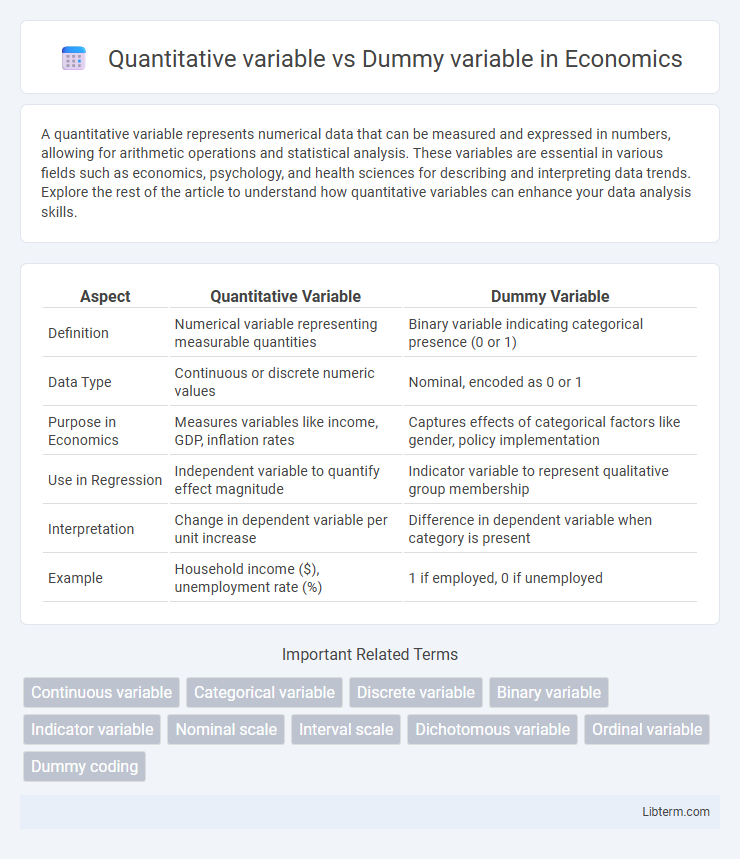A quantitative variable represents numerical data that can be measured and expressed in numbers, allowing for arithmetic operations and statistical analysis. These variables are essential in various fields such as economics, psychology, and health sciences for describing and interpreting data trends. Explore the rest of the article to understand how quantitative variables can enhance your data analysis skills.
Table of Comparison
| Aspect | Quantitative Variable | Dummy Variable |
|---|---|---|
| Definition | Numerical variable representing measurable quantities | Binary variable indicating categorical presence (0 or 1) |
| Data Type | Continuous or discrete numeric values | Nominal, encoded as 0 or 1 |
| Purpose in Economics | Measures variables like income, GDP, inflation rates | Captures effects of categorical factors like gender, policy implementation |
| Use in Regression | Independent variable to quantify effect magnitude | Indicator variable to represent qualitative group membership |
| Interpretation | Change in dependent variable per unit increase | Difference in dependent variable when category is present |
| Example | Household income ($), unemployment rate (%) | 1 if employed, 0 if unemployed |
Introduction to Quantitative and Dummy Variables
Quantitative variables represent numerical data that can be measured and ordered, such as height, weight, or temperature, enabling statistical analysis involving means, variances, and correlations. Dummy variables, also known as indicator variables, are categorical variables converted into numerical format, typically represented as 0 or 1, to indicate the presence or absence of a particular attribute in regression models. Understanding the distinction between quantitative and dummy variables is essential for selecting appropriate statistical techniques and ensuring accurate interpretation of data analysis results.
Defining Quantitative Variables
Quantitative variables represent measurable quantities that can be expressed numerically, allowing for arithmetic operations such as addition and subtraction. These variables can be continuous, like height or weight, or discrete, such as the number of students in a class. Unlike dummy variables, which are categorical and take values of 0 or 1 to indicate the presence or absence of a characteristic, quantitative variables provide a scale for assessing magnitude or amount.
Defining Dummy Variables
Dummy variables represent categorical data in regression analysis by converting qualitative attributes into binary indicators, typically coded as 0 or 1. Unlike quantitative variables that measure numerical values, dummy variables capture the presence or absence of a specific category, enabling statistical models to include nominal or ordinal data. Defining dummy variables involves selecting a reference category and creating binary columns for other categories, facilitating clearer interpretation and avoiding multicollinearity.
Key Differences Between Quantitative and Dummy Variables
Quantitative variables represent measurable quantities with meaningful numerical values, such as height, weight, or temperature, allowing for arithmetic operations and statistical analysis. Dummy variables, also known as binary or indicator variables, take values of 0 or 1 to denote the presence or absence of a categorical attribute, enabling the inclusion of qualitative data in regression models. Key differences include the nature of data--continuous versus categorical--and their use in analysis, where quantitative variables capture magnitude and variability, while dummy variables encode categorical distinctions for statistical interpretation.
Examples of Quantitative Variables in Data Analysis
Quantitative variables represent numerical values that can be measured or counted, such as age, income, temperature, or height, which are essential for statistical analysis and modeling. These variables allow for meaningful arithmetic operations like addition and averaging, enabling researchers to identify trends and relationships within large datasets. In contrast, dummy variables are categorical variables converted into binary indicators, such as gender (male = 0, female = 1) or presence/absence measures, used primarily in regression models to represent qualitative data.
Applications of Dummy Variables in Regression
Dummy variables transform categorical data into numerical form, enabling regression models to include qualitative factors such as gender, region, or product types. Their applications in regression analysis allow for testing group differences, estimating the impact of categorical predictors, and capturing interaction effects between categorical and continuous variables. By coding categories as 0s and 1s, dummy variables facilitate the incorporation of non-numeric attributes, improving model interpretation and predictive accuracy in econometrics, social sciences, and marketing analytics.
Encoding Categorical Data: The Role of Dummy Variables
Quantitative variables represent measurable quantities expressed numerically, while dummy variables encode categorical data into binary format for statistical analysis. Dummy variables transform categories into 0s and 1s, enabling inclusion in regression models or machine learning algorithms that require numeric input. This encoding technique preserves categorical distinctions and facilitates interpretation of model coefficients without imposing ordinal relationships.
Impact on Statistical Models: Quantitative vs Dummy Variables
Quantitative variables provide continuous numeric data that enable statistical models to capture detailed variation and establish precise relationships through methods like regression analysis. Dummy variables, representing categorical data as binary indicators, simplify the inclusion of qualitative factors but can reduce model granularity and require careful interpretation of coefficients for category effects. The choice between quantitative and dummy variables significantly influences model accuracy, interpretability, and the ability to detect nuanced effects within datasets.
Common Mistakes in Using Dummy and Quantitative Variables
Common mistakes in using dummy and quantitative variables include treating dummy variables as continuous, leading to incorrect interpretations and biased regression coefficients. Another error is failing to create appropriate reference categories for dummy variables, which distorts comparison effects in the model. Additionally, ignoring multicollinearity caused by including all categories of a categorical variable without dropping a reference dummy results in perfect linear dependence and estimation issues.
Choosing the Right Variable Type for Your Analysis
Quantitative variables represent measurable numerical values that allow for arithmetic operations and statistical analysis, while dummy variables are categorical variables converted into binary indicators for regression models. Selecting the appropriate variable type depends on the research objective: use quantitative variables for continuous data analysis and dummy variables to encode categorical factors in regression equations. Proper variable choice ensures accurate model interpretation and strengthens the validity of statistical conclusions.
Quantitative variable Infographic

 libterm.com
libterm.com